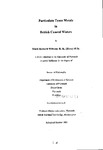Particulate Trace Metals in British Coastal Waters
| dc.contributor.author | Williams, Mark Richard | |
| dc.contributor.other | School of Biological and Marine Sciences | en_US |
| dc.date.accessioned | 2013-09-24T12:21:03Z | |
| dc.date.available | 2013-09-24T12:21:03Z | |
| dc.date.issued | 1995 | |
| dc.identifier | NOT AVAILABLE | en_US |
| dc.identifier.uri | http://hdl.handle.net/10026.1/1934 | |
| dc.description.abstract |
Key processes affecting the transport of particulate trace metals in the coastal waters of the Irish and North Seas have been examined. Sample collection and experimentation was carried out on board R.R-S. Challenger in January 1992 (Irish Sea) and in December 1992 and November 1993 (North Sea). Particulate samples were digested in IM HCI and the concentrations of Ca, Cd, Co, Cu, Fe, Mn, Pb and Zn were determined, together with the 206/207Pb isotopic ratio. In the North Eastern Irish Sea the concentrations of suspended particulate trace metals were affected significantly by tidal processes, such that ebb tides transport particles of higher trace metal concentrations from the nearshore, while flood tides transport metal-depleted particles from offshore. This tidally-induced transport was confirmed by complementary 206/207Pb analyses, which showed the value of this technique in particle tracing. In the North Sea suspended particulate trace metal concentrations were higher adjacent to industrialised estuaries and high Pb concentrations were found m the Tyne/Tees region (in the range 200 - 340 ug g-1), in combination with low 206/207Pb suggesting an anthropogenic origin. Estimated fluxes of trace metals from the Humber Estuary to the North Sea were relatively small compared to the PARCOM inputs to the estuary. There was little evidence of interannual variability in these fluxes compared to those obtained in December 1988. Samples of end-members of the Humber Plume particle mixing series (estuary and cliffs) were used in radiochemical uptake studies, which indicated a response time of about 1 day for 109Cd, 137Cs and 65Zn to reach a new equihbrium. When the end-members were mixed together in various proportions they showed the uptake of 109Cd and 54Mn behaved non-additively. Settling of suspended particulate trace metals in the plume region was examined in unique experiments involving stable and radioisotopes. It was shown that trace metals were preferentially associated with different settling fractions. Lead was associated with slow settling particles whereas Cu was associated with particles settling more rapidly. The results presented in this dissertation allowed the development of a conceptual model for fine sediment transport for trace metals, which could be interfaced with established hydrodynamic models. | en_US |
| dc.description.sponsorship | Plymouth Marine Laboratory, Plymouth and British Maritime Technology, Southampton | en_US |
| dc.language.iso | en | en_US |
| dc.publisher | University of Plymouth | en_US |
| dc.title | Particulate Trace Metals in British Coastal Waters | en_US |
| dc.type | Thesis | en_US |
| plymouth.version | Full version | en_US |
| dc.identifier.doi | http://dx.doi.org/10.24382/1353 | |
| dc.identifier.doi | http://dx.doi.org/10.24382/1353 |
Files in this item
This item appears in the following Collection(s)
-
01 Research Theses Main Collection
Research Theses Main


